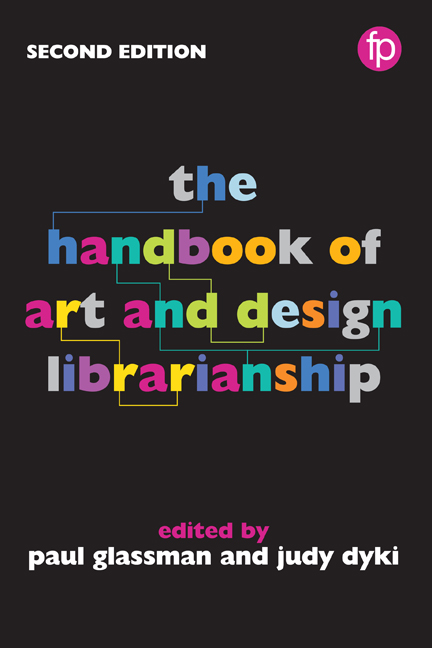Book contents
- Frontmatter
- Contents
- List of figures and tables
- Notes on contributors
- Foreword
- Preface
- Part I Roles and responsibilities
- Part II Materials and collection management
- 6 Visual resources: from analogue to digital and beyond
- 7 Developing digital collections
- 8 Inspirational encounters: the management and use of archives and special collections in the art and design library
- 9 What is special about special collections?
- 10 Artists’ books in the art and design library
- 11 Art documentation: exhibition catalogues and beyond
- 12 Tactile libraries: material collections in art, architecture and design
- 13 Seeing the bigger picture: archival description of visual information
- Part III Teaching and learning
- Part IV Knowledge creation
- Part V The physical environment
- Part VI Promotion and sustainability
- Appendix Library profiles
- Index
9 - What is special about special collections?
from Part II - Materials and collection management
Published online by Cambridge University Press: 08 June 2018
- Frontmatter
- Contents
- List of figures and tables
- Notes on contributors
- Foreword
- Preface
- Part I Roles and responsibilities
- Part II Materials and collection management
- 6 Visual resources: from analogue to digital and beyond
- 7 Developing digital collections
- 8 Inspirational encounters: the management and use of archives and special collections in the art and design library
- 9 What is special about special collections?
- 10 Artists’ books in the art and design library
- 11 Art documentation: exhibition catalogues and beyond
- 12 Tactile libraries: material collections in art, architecture and design
- 13 Seeing the bigger picture: archival description of visual information
- Part III Teaching and learning
- Part IV Knowledge creation
- Part V The physical environment
- Part VI Promotion and sustainability
- Appendix Library profiles
- Index
Summary
Introduction
Art libraries are more likely than any other branch or special-subject libraries to maintain protected or limited access separate collections within their boundaries, known professionally as ‘special collections’ (Carter and Whittaker, 2015, 354). The reasons such distinctions are necessary are as varied as art libraries themselves. Because scholars in the discipline of art and art history study material culture, the object rendering the information itself can engender a separate meaning from the textual aspect. Much of art's literature becomes an object of study and appreciation in itself. A second reason for maintaining restricted collections is that a good deal of art documentation is still limited to physical print (often for reasons of intellectual property rights control) and these printed materials are the only form of dissemination; this unique form can become hard to replace. Books become special because of their lack of availability or cost. A third reason for maintaining restricted collections is user-driven: artists value the object qua object and digital surrogates do not satisfy that aesthetic experience.
Though few of these criteria would qualify these titles for transfer into a standalone special collection, this material falls under the whimsical library sobriquet of ‘medium rare’: housed in a restricted section of the art library. In the age of digital surrogacy and laptop delivery, the criteria for these special collections are both fast changing and long standing (Barker, 2009). As the cost of storing, cataloguing and conserving special material becomes higher than for open-stack or digital literature, art librarians as well as their administrators necessarily need to examine the question, ‘just how special is special?’ What can or should constitute an art-subject special collection in 21st-century librarianship?
Art libraries fall under three broad genres, a classification based more on their constituencies than their material content: academic, museum, and art or design school libraries. The organization and mission of the special collection within each of these library types fluctuates with the identity of the library. For example, art museum libraries can in one sense be considered standalone special collections in themselves: they are noncirculating and object-based; their items are frequently catalogued descriptively more than in other art collections; and they often supervise their readers.
- Type
- Chapter
- Information
- The Handbook of Art and Design Librarianship , pp. 89 - 98Publisher: FacetPrint publication year: 2017
- 1
- Cited by



